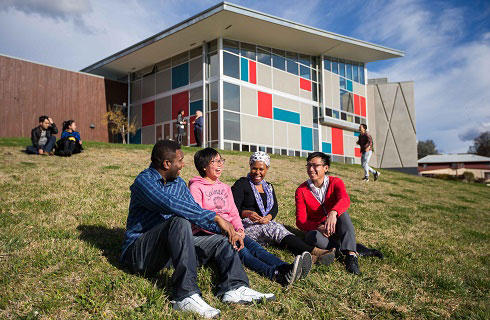视觉艺术美术学士-平面设计
Bachelor of Fine Arts in Visual Arts- Graphic Design

学历文凭
Bachelor Degree

专业院系
Department of Visual Arts

开学时间

课程时长

课程学费

国际学生入学条件
If you have attended a postsecondary institution, such as a college or university, outside the United States, submit course by course credentials evaluated through one of the following evaluation services.
Documents in languages other than English must be accompanied by a certified English translation.
Request an official transcript from your high school. Counselors may send us your transcripts electronically through the Common App School Report or they may mail a transcript to our office.
Duolingo English Proficiency Test: 115
Test of English as a Foreign Language (TOEFL): 80
International English Language Testing System (IELTS): 6.5
SAT (Evidence-Based Reading Writing Section): 500
Cambridge English Qualification: Cambridge B2 First, C1 Advanced or C2 Proficiency 176
English composition at a U.S. College/University: grade of C or better
Average GPA: 3.96
Average SAT Score: 1303 (2-part)
Average ACT Composite Score: 25.7
IDP—雅思考试联合主办方

雅思考试总分
6.5
- 雅思总分:6.5
- 托福网考总分:80
- 托福笔试总分:160
- 其他语言考试:Duolingo English Proficiency Test: 115
CRICOS代码:
申请截止日期: 请与IDP联系 以获取详细信息。
课程简介
The Graphic Design concentration delves into those complex questions that absorb both the novice and the expert in the expanding arena of visual communication. The curriculum encourages a rigorous handling of thought processes combined with inquiries springing from the traditional through the transitional and emerging media. The emergence of new multifaceted word and image forms opens the way for informed expression solidly built on curiosity, honest work and the need to reason and create. The faculty allows for the intellectual, intuitive, and perceptual approaches to problem solving, all balanced on the fundamental belief that effective communication, not style, is the desired goal. Although the Graphic Design concentration constantly acknowledges the influence and significance of new technologies in education, the question of essential sources for creative formative work is addressed through attention to development in the following areas: mark-making, reading, and writing. These areas of observation are anchor points for the development of the graphic designer. Together, they provide the student with a comprehension of the intellectual and visual environment in which we live. The study of design history, in association with instruction in typography, word and image, sign/symbol, semiotics, and a range of digital and analog production methods, forms the foundation for a commitment through which research and expression can be accomplished.
相关申请
 预科
预科 奖学金
奖学金 实习机会
实习机会 在校学习
在校学习 跨境学习
跨境学习 校园授课-线上开始
校园授课-线上开始 在线/远程学习
在线/远程学习
开学时间&学费
学费信息仅供参考,请与IDP联系以获取详细信息
| 开学时间 | 时长 | 学费 | 地点 |
|---|
学校排名

世界排名501
数据源:
泰晤士高等教育世界大学排名
关于马里兰大学巴尔的摩分校

马里兰大学-巴尔迪默分校创建于 1963 年,是一所公立综合大学。该校分为三个学院,数学与自然科学学院,工程和信息科技学院以及艺术人文和社会科学学院。马里兰大学提供本科和硕士项目,专业多达54个。 马里兰大学共有学生1万多名。师生比1:20。校园社团活动丰富,全校有250个学生组织和20个兄弟会和姐妹会。 学校占地 500 英亩,距离巴尔迪默市区15分钟车程,距华盛顿特区45分钟车程。马里兰大学的研究和科技园占地71英亩,为许多大学合作的科技、生化和实验组织提供研究基地,其中不乏美国政府研究机构。 马里兰大学在美国大学排名2012为第157名. 校园社团活动丰富,全校有250个学生组织和20个兄弟会和姐妹会。
本校相关课程

Bachelor of Science in Statistics
学历文凭
Bachelor Degree
开学日期
课程费用总额


Bachelor of Science in Mathematics
学历文凭
Bachelor Degree
开学日期
课程费用总额


应用数学哲学博士
学历文凭
Ph.D.
开学日期
课程费用总额


应用数学理学硕士
学历文凭
Masters Degree
开学日期
课程费用总额


Bachelor of Fine Arts in Visual Arts
学历文凭
Bachelor Degree
开学日期
课程费用总额


Bachelor of Arts in Visual Arts
学历文凭
Bachelor Degree
开学日期
课程费用总额

其他相关课程

Bachelor of Science in Graphic Communications Technology
 伊利诺伊州立大学-INTO USA
伊利诺伊州立大学-INTO USA学历文凭
Bachelor Degree
开学日期
课程费用总额


数字图像设计证书
 弗莱明学院
弗莱明学院学历文凭
Bachelor Degree
开学日期
课程费用总额


Bachelor of Fine Arts in Graphic Design
 马歇尔大学 - INTO USA
马歇尔大学 - INTO USA学历文凭
Bachelor Degree
开学日期
课程费用总额


平面设计美术学士学位
 科罗拉多州立大学-INTO USA
科罗拉多州立大学-INTO USA学历文凭
Bachelor Degree
开学日期
课程费用总额


Doctor of Philosophy in Design - Graphic Design
 明尼苏达大学双城分校
明尼苏达大学双城分校学历文凭
Ph.D.
开学日期
课程费用总额


Bachelor of Fine Arts: Graphic Design
 马萨诸塞州洛厄尔大学 - Navitas USA
马萨诸塞州洛厄尔大学 - Navitas USA学历文凭
Bachelor Degree
开学日期
课程费用总额










